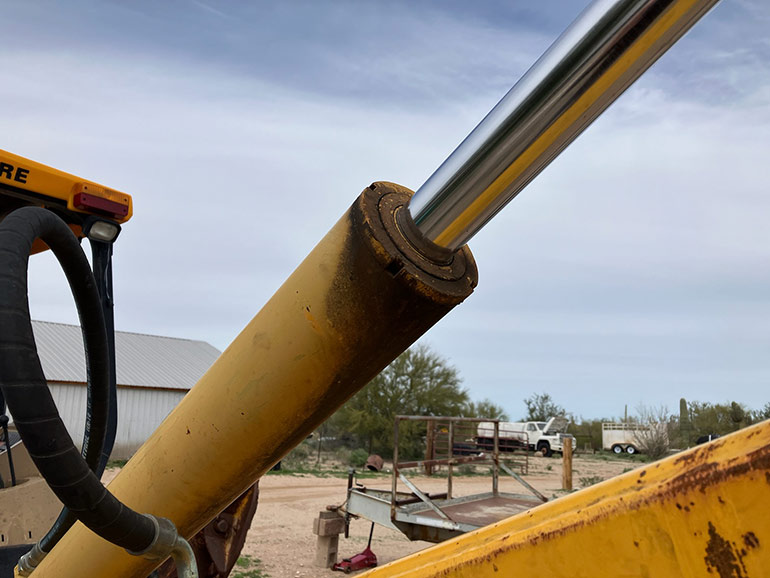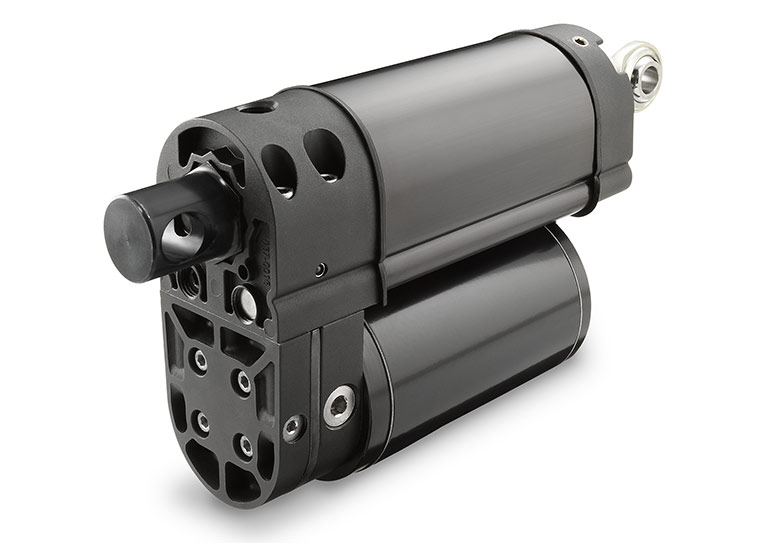Electrohydraulic actuators are standalone, self-contained systems that perform powerful tasks without external piping. They typically include an electric servomotor driving a hydraulic pump — often an axial-piston unit. Other components include a hydraulic cylinder, tank, valving and charging circuits.
Because they are fitted with their own closed fluid circuit, they require only a small amount of hydraulic fluid and they eliminate a central hydraulic power unit. As a typical unit is quite compact and lightweight, the electro-hydrostatic actuator (EHA) has been used extensively in aircraft. But it is increasingly being used in industrial, marine and offshore applications, as well as for agricultural tasks. Researchers are also considering EHA use to electrify mobile equipment operations.

However, a serious concern with EHAs is leakage. External leaks, typically caused by rod seal and wiper failures, are easy to spot with a visual inspection. But internal leaks, usually the result of piston seal wear and tear, often go unnoticed. But they can lead to control issues, loss of performance and potentially serious malfunctions.
Researchers in China recently offered a novel method to detect internal EHA leakage using artificial intelligence methods. In a paper published by London-based The Institution of Engineering and Technology titled “A method to detect internal leakage of hydraulic cylinders by combining data augmentation and multiscale residual CNN” the authors, Qingchuan He of Zhejiang Sci-Tech University and Xiaotian Lyu of Zhejiang CHR Intelligent Equipment Co. proposed a way to solve the problem with more than 99% accuracy.
Undetected leaks
According to the authors, at present internal leakage in an EHA cannot be accurately detected by using operational data alone. Some studies have been carried out on detection of internal leakage in hydraulic cylinders by monitoring pressure or other signals. But in general, the proposed methods depend on high-precision pressure gauges, flow sensors and complex leakage-measuring devices. The EHA is a compact hydraulic system, and it is usually impossible to install high precision and complex measuring devices due to space constraints and weight limitations.
Moreover, said the authors, the amount of internal leakage changes with load and velocity of the rod, and also with hydraulic oil temperature. Detection accuracy cannot be guaranteed by analyzing changes in pressure signal features when a hydraulic cylinder operates under non-stationary load and velocity conditions. Therefore, they said, it is necessary to develop an internal leakage detection method in hydraulic cylinders with no additional complex measuring devices.
Neural networks
Instead, they propose a convolutional neural network (CNN) method to detect internal leakage based on the relationship between operational parameters of the EHA and leakage in the hydraulic cylinder.

A neural network is a method in artificial intelligence that teaches computers to process data much like the way a human brain works. It is a type of machine learning, called deep learning, that uses interconnected nodes or neurons in a layered structure.
According to Arm Ltd., a technology company based in Cambridge, England, a CNN is a type of artificial neural network used primarily for image recognition and processing, due to its ability to recognize patterns in images. A CNN is a powerful tool but requires millions of data points for training. CNNs must be trained with high-power processors, such as a GPU or an NPU, if they are to produce results quickly enough to be useful.
While CNNs are designed to solve problems with visual imagery, they also have many applications outside of image recognition and analysis, including natural language processing, drug discovery, and health risk assessments. CNNs also help provide depth estimation for self-driving cars.
In recent years, said Qingchuan and Xiaotian, convolutional neural networks are gradually being developed as a computational framework to detect faults in mechanical and electrical products.
Tracking data
A typical EHA system is mainly composed of one permanent magnet synchronous motor (PMSM), an axial piston pump, oil tank, hydraulic actuator, and corresponding circuits. The PMSM is controlled through closed-loop vector control. Motor dynamics can be described by a model that includes parameters like load torque, viscous friction of the rotor system, rotation speed, total inertia of motor, number of pole pairs, flux linkage caused by permanent magnets, motor current, theoretical pump volumetric displacement, and the inlet and outlet port pressures under working conditions.
Other considerations are the force balance based on the piston surface, velocity and displacement of the hydraulic actuator, the total inertia mass applied to the actuator, viscous friction, stiffness, external applied force, and the internal leakage flowrate in the hydraulic cylinder.
The authors presented a method to align these multi-source signals with different forms by using the motor current as a benchmark. The raw monitoring signals of an EHA usually include inlet and outlet port pressure of the hydraulic cylinder, motor currents, rotation speed and displacement of the hydraulic actuator. The signals also change greatly with the amplitude and frequency under variable load and velocity condition.
Because the number of monitoring signals are relatively small, a feedforward neural network (FFNN) based data augment method was developed to increase parameters of the input data set. The variables, including velocity and differential pressure, were set as the input of FFNN model, and rotation speed or current was set as the output. Construction of the neural network used MATLAB. And a general method on how to detect internal leakage by combining signals alignment, data augmentation and multiscale residual CNN was proposed. Complete details are found in the authors’ paper.
Experimental results
The basic theory and mathematical models were subsequently tested via an experimental setup. The test bench mainly consists of the motor, pump, tank, and actuator, one bidirectional throttle valve, two safety valves and some sensors. The PMSM directly drives the pump; and pressure sensors detect pressure in the chambers of the hydraulic actuator. An LVDT linear position sensor measures movements of the hydraulic actuator and feeds back position information to the control system. Rotation speed and current of the PMSM were collected from the motor driver.
Different degrees of internal leakage of the hydraulic cylinder were simulated by adjusting the bidirectional throttle valve. The signals from displacement, velocity, pressures, motor current and rotation speed were collected synchronously.
The velocity signals note obvious differences between serious leakage and normal states. This means that serious leakage has a major influence on control accuracy. Generally, motor speed and current increased with the leakage when pressurized oil enters the hydraulic actuator. Similarly, the motor speed and current decreased with the severity of fault when oil output exits the hydraulic actuator. However, the changes are not always proportional to the serious leakage because the actual condition is relatively complicated. For example, even a small fluctuation of the load will result in changes in motor speed and current. Therefore, the detection accuracy of leakage cannot be guaranteed by visually tracking the changes in signals. Thus, all the data collected were used for training the FFNN model, repeated over numerous trials.
In the end, predicted values neared the actual measured values. Four experimental datasets were used to train the multiple residual CNN and validate the effectiveness of the proposed approach. They included processed signals such as velocity, pressure difference, motor current and rotation speed, and also predicted motor current and rotation speed, and it obtained test accuracy of 91.2% to 99.8%.
By combining methods of signals alignment, data augmentation and multiscale residual CNN modelling, the detection accuracy of internal leakage control signals was impressive. The results show that the proposed method can effectively improve the accuracy under non-stationary load and velocity conditions.
Moreover, multiscale residual CNNs are usually seen as a black box, where it is unclear what features of a model are used for internal leakage detection decisions. In the future, researchers could focus on how to develop an explainable deep learning algorithm which can visualize the CNNs’ model.
In addition, this article only studied the internal leakage fault in a hydraulic cylinder and did not explore internal leakage in the pump. The next step will be to study multiple internal leakage faults in an EHA.
Filed Under: Components Oil Coolers, Cylinders & Actuators, Mobile Hydraulic Tips, News, Technologies, Trending